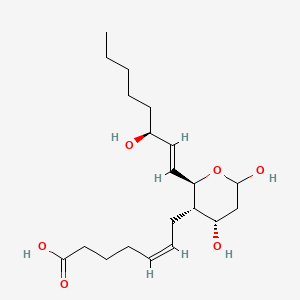Thromboxane b2
Thromboxane b2 is a lipid of Fatty Acyls (FA) class. Thromboxane b2 is associated with abnormalities such as endothelial dysfunction, Diabetes Mellitus, Non-Insulin-Dependent, Diabetes Mellitus, Ischemia and Thrombocytosis. The involved functions are known as Platelet Activation, Excretory function, Anabolism, Inflammation and mRNA Expression. Thromboxane b2 often locates in Endothelium, Hepatic and Microsomes, Liver. The associated genes with Thromboxane b2 are PTGS2 gene, prothrombin fragment 2 and CCL14 wt Allele.
Cross Reference
Introduction
To understand associated biological information of Thromboxane b2, we collected biological information of abnormalities, associated pathways, cellular/molecular locations, biological functions, related genes/proteins, lipids and common seen animal/experimental models with organized paragraphs from literatures.
What diseases are associated with Thromboxane b2?
Thromboxane b2 is suspected in endothelial dysfunction, Diabetes Mellitus, Non-Insulin-Dependent, Diabetes Mellitus, Ischemia, Thrombocytosis, Acute Coronary Syndrome and other diseases in descending order of the highest number of associated sentences.
Related references are mostly published in these journals:
| Disease | Cross reference | Weighted score | Related literature |
|---|
Possible diseases from mapped MeSH terms on references
We collected disease MeSH terms mapped to the references associated with Thromboxane b2
PubChem Associated disorders and diseases
What pathways are associated with Thromboxane b2
There are no associated biomedical information in the current reference collection.
PubChem Biomolecular Interactions and Pathways
Link to PubChem Biomolecular Interactions and PathwaysWhat cellular locations are associated with Thromboxane b2?
Visualization in cellular structure
Associated locations are in red color. Not associated locations are in black.
Related references are published most in these journals:
| Location | Cross reference | Weighted score | Related literatures |
|---|
What functions are associated with Thromboxane b2?
Related references are published most in these journals:
| Function | Cross reference | Weighted score | Related literatures |
|---|
What lipids are associated with Thromboxane b2?
There are no associated biomedical information in the current reference collection.
What genes are associated with Thromboxane b2?
Related references are published most in these journals:
| Gene | Cross reference | Weighted score | Related literatures |
|---|
What common seen animal models are associated with Thromboxane b2?
There are no associated biomedical information in the current reference collection.
NCBI Entrez Crosslinks
All references with Thromboxane b2
Download all related citations| Authors | Title | Published | Journal | PubMed Link |
|---|---|---|---|---|
| Ferro D et al. | Determinants of enhanced thromboxane biosynthesis in patients with systemic lupus erythematosus. | 1999 | Arthritis Rheum. | pmid:10616019 |
| Uriu K et al. | Effect of acute thromboxane A2 inhibition on the renal hemodynamics in a spontaneously non-insulin-dependent diabetic rat, Otsuka Long-Evans Tokushima Fatty rat. | 1999 Jul-Aug | J. Diabetes Complicat. | pmid:10616856 |
| Tanus-Santos JE et al. | The hemodynamic effects of endothelin receptor antagonism during a venous air infusion in dogs. | 2000 | Anesth. Analg. | pmid:10624986 |
| Dahlin KL et al. | Amitriptyline-induced release of endothelin-1 in isolated perfused and ventilated rat lungs. | 1999 | Pharmacol. Toxicol. | pmid:10628905 |
| Perneby C et al. | Optimization of an enzyme immunoassay for 11-dehydro-thromboxane B(2) in urine: comparison with GC-MS. | 1999 | Thromb. Res. | pmid:10632465 |
| Miura M and Kurimoto F | [Thromboxane B2 (TXB2)]. | 1999 | Nippon Rinsho | pmid:10635957 |
| González E et al. | Evolution of streptozotocin-pancreatic damage in the rat: modulatory effect of endothelins on the nitridergic and prostanoid pathway. | 1999 | Nitric Oxide | pmid:10637124 |
| Stewart KG et al. | Estrogen decreases prostaglandin H synthase products from endothelial cells. | 1999 Nov-Dec | J. Soc. Gynecol. Investig. | pmid:10643586 |
| Gajdos M et al. | [The effect of monotherapy with ciprofibrate and in combination with acetylsalicylic acid on the spectrum of lipids, thromboxane and fibrinogen in patients with atherosclerosis and hyperlipoproteinemia]. | 1999 | Bratisl Lek Listy | pmid:10645034 |
| Montini G et al. | Renal glomerular response to the inhibition of prostaglandin E2 synthesis and protein loading after the relief of unilateral ureteropelvic junction obstruction. | 2000 | J. Urol. | pmid:10647684 |
| Chou TC et al. | Mechanism of inhibition of platelet aggregation by HCL-31D. | 2000 | Eur. J. Pharmacol. | pmid:10650152 |
| Landoni MF et al. | Enantiospecific pharmacokinetics and pharmacodynamics of ketoprofen in sheep. | 1999 | J. Vet. Pharmacol. Ther. | pmid:10651463 |
| Hansen JM et al. | Effects of nitric oxide blockade and cyclosporin A on cardiovascular and renal function in normal man. | 1999 | J. Hypertens. | pmid:10658936 |
| Matsumoto H and Nakao T | Elevated urinary excretion of thromboxane B2 in adults with minimal-change nephrotic syndrome. | 2000 | Clin. Nephrol. | pmid:10661487 |
| Leese PT et al. | Effects of celecoxib, a novel cyclooxygenase-2 inhibitor, on platelet function in healthy adults: a randomized, controlled trial. | 2000 | J Clin Pharmacol | pmid:10664917 |
| Okumura M et al. | Renal production of thromboxane and prostaglandins in a rat model of type 2 diabetes. | 2000 | Life Sci. | pmid:10670825 |
| Wu TM et al. | Inhibitory effect of hexapeptide (RGRHGD) on platelet aggregation. | 2000 | Thromb. Res. | pmid:10674405 |
| De La Cruz JP et al. | Effect of DT-TX 30, a combined thromboxane synthase inhibitor and thromboxane receptor antagonist, on retinal vascularity in experimental diabetes mellitus. | 2000 | Thromb. Res. | pmid:10680643 |
| Zeng W et al. | [Relationship between PGI2, TXA2 and threatened preterm]. | 1998 | Hua Xi Yi Ke Da Xue Xue Bao | pmid:10684102 |
| Nagano K et al. | Prostanoids regulate proliferation of vascular smooth muscle cells induced by arginine vasopressin. | 2000 | Eur. J. Pharmacol. | pmid:10686292 |
